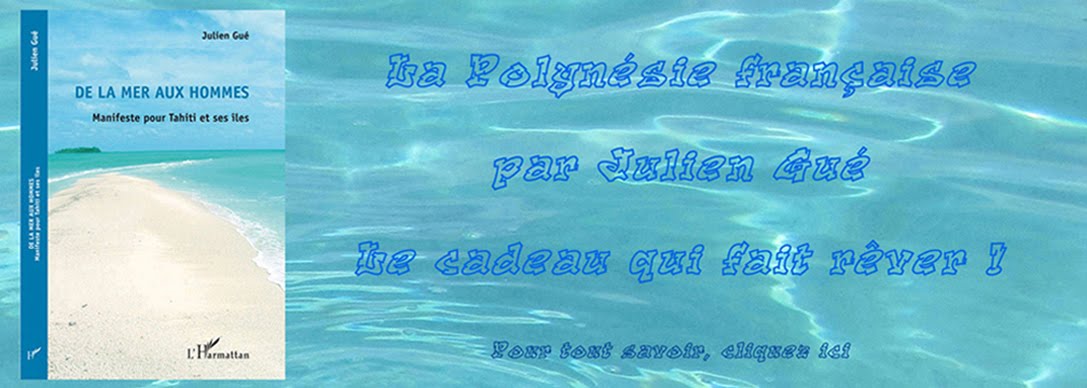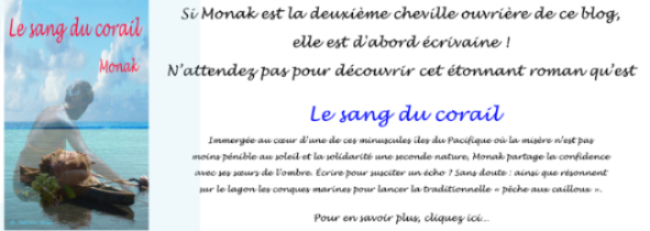Célestine Hitiura Vaite's Key
You want to immerse yourself in the Polynesian islands
and understand the spirit of a people? Don’t miss the trilogy of Célestine Hitiura
Vaite.
The story is sipped like milk,
it's swallowed in one gulp! Both the Tahitian author takes you by the heart, by
humor, crying, in the mazes of a family saga. They are not less than a hundred
or more, distributed over five generations. The narrative is alert. The subtle
analysis, carried gently, leaves you free to your opinion: it's the undeniable
talent of Celestine, neither prudish nor vengeful.
 |
| Fruits in their sheets |
A gallery of portraits with the flavors, colors, scents, musicality of
these three languages mixed of South Pacific: English, French, and the
truculent Reo Tahiti (one of Mā'ohi
languages). A panorama fed by insular myths and entangled in a topicality that
upsets again the lifestyle of a culture which was in harmony with the
environment, and crumbles miserably in these pivotal years of the 21st century.
With Breadfruit (2000 in Australia, “L'Arbre
à Pain” in 2003 at Tahiti) Frangipani
(2004, “Frangipanier”, 2005) and Tiare
(2006), three flagship titles, rooted in the tree symbolism that sticks to the
heart and body of the vahine.
The Celestine mystery or "that's
all"
The work, conceived from
variegated languages, first published in Australia, then
at Tahiti, enjoys the gift
of the first Polynesian bestseller: it is the only one so far. Translated into
many languages, for over a dozen countries, it also appears in e-books. Award-winning,
both in Anglophone space (New South Wales Premier's Literary Awards
in 2004 and Orange Prize in 2006) and in Francophone area, it's a
Pacific ethnographic reference.
 |
| Blooming girls and ironwood |
What gives her this runaway
success? Is because she dotted some I's
on the fate of her islands? Indeed, she breaks the tourist image of "The
New Cythera" conveyed by the first discoverers-coasters and hammered by
the collective imagination of the world. From where does she draw her
consecration? From the literary quality of his writing. She equips each of her
three books with a new dynamics and atmosphere: with cookie cutter for the
first one, between exasperation and aspirations for the second, and under the
sign of the gravity, the meditation and the quietening for the last.
Would she stand out for having
been able to make the many voices heard, the ones that make up the bulk of the
Polynesian community, whilst respecting the contradictions? In this composite
assembly, Chinese and popa'a* are part of the landscape, for neighborhood
commerce, marriage or a paternity accident.
 |
| A small town on runway edge, Faa'a |
So, she offers us to see the
complexities of the social, its pitfalls as its temporary or long-term
outcomes; the different facets of a community whose members are not
caricatures.
Multilingual, she chose her new adopted country,
Australia, as a forum for her topic. It was the right move. The listening was
there, carrying the echoes of its native tiny island. Chance did the rest ...
or rather her look of empathy that gives the subject lucidity and objectivity.
 |
| A small shop like this one... |
At her late thirties,
Celestine seems to have said everything. Since the end point of Tiare, she has not undertaken other
writing projects, if not through conferences that invite her to speak on all
continents.
Is atypical Celestine? In a
way... but isn't she fulfilling the legacy of her ancestors, ploughing the
waves of the great ocean?
The breadfruit or the tree of life
Tree of life as of survival,
magically appeared as manna for overcoming scarcity according to legend, the tumu'uru, breadfruit tree, always plays
the role of food palliative in the most
needy areas, through its presence in any garden.
Women's book because most of
dialogues are theirs, and also their gossip disclosed by
"radio-coconut", the well-known word of mouth. It chronicles the
tribulations and the daily miracle of the daily bread, school needs and
learning of life.
 |
| A gas station like this one... |
Is the book of
misunderstandings? Where each of the sexes remains aloof, shows off her banner
and where the word love doesn't take the same meaning. Book of the
criss-crossing, where the totem, beer and ghosts adjoin the broom, the frying
pan and the 'uru in all the sauces...
Between squabbling and quibbling, the family spirit ensures the cohesion of the
clan: everyone confined in a lack of real communication.
Materena, Mother Courage with
her declinable name, is looming in filigree.
Frangipani or the palaver tree
With Frangipani, the tale relies on more narration. It tries to resume
the dialogue initiated earlier. It abandons the appearances behind which each
sought to hide one's modesty.
 |
| Some "trucks" to move |
It's the tree of the birth of
love, of the encounters point. It which affirms the freedom of everyone,
whatever it takes and puts an end to possession which distorts love. It is the
tree of revelation, that which accompanies the ranges of the ukulele, promises and vows.
 |
| Unforgettable school essays... |
This is the book of the face
to face and mutual release. Book of the knowledge, orally transmitted by the
female long line. Against a background of radical disturbances that lead
Polynesia in the era of profitability and consumption like a Westerner, it deals with violence, abandonment, the
relationship to work and money, grief, passion, dislikes, unspoken. At this
intensity of daily experience, this life force interferes, emanating from the
little people, left out or recycled. Among them the raerae* and the unemployed
persons, following the closure of the Experimental Center of Pacific of
Moruroa.
It's the book of the paradox
of shadow and rain, of sun and fiu, of shelter and fertility under the
guardianship tree. "The rain is very
good for the soul, especially when one is a woman”, highlights Materena in
a particularly witty parable.
Looming in filigree, Leilanie
and her healer's fate.
Tiare, or the sweet bush
For the final, Célestine
didn't stick to the only emblem of Tahitian flower, the tiare, brought to the right ear for married women or in love. Tiare is the book of childhood with the
new-born who bears the name. Pages, so touching, with the "re-birth"
of Pito, taking upon his man full status. The tiare "sugar scented", would it be the burning bush of
love?
 |
| Laughters and games |
After a foray into the ghettos
of misery, Célestine operates a revolution in his writing. With many
monologues, she adopts the perspective of the male thread of these three
volumes: Pito*, the navel of the world?
The tone speckles with bursts,
is tinged with lyricism and cheeky romanticism with the leitmotif of "La vie en Rose" in songs and between the lines.
The hymn to love of Célestine
Announced in the subtitle of
the first booklet, it's a hymn to love the partner, child, of each and
oneself... lived all over the novels.
 |
| Célestine, heart-to-heart with an author |
Célestine exudes so much
emotion than she gives the thrill to the reader. And under the playful aspect
of his writing, she provides the elements that give him to reflect on his
condition. The target reader, the beloved reader is primarily Polynesian. She
does not judge, she's talking about each of them.
Célestine a feminist?
Certainly, in the noblest sense of the term which is actually the most real. No
misandry. The issue is vital: to recognize each in one's integrity. Three steps
to tell it: that of comical nature when sparks fly, then the passion where the pot
overflows and finally that the “fondant” that melts in the mouth where the
"escrime*" (read ice-cream)
welcomes tongue and throat.
 |
| Faa'a, a quiet bay |
As for the universal readers,
she takes care of them: she guides with little white pebbles so that they
doesn't get lost on the way. "That's
what I'm talking about, about us, Polynesians. Such as we are, such as we
perceive us from inside", she means, substance, in an interview with
the weekly To'ere in 2003.
"So that is why, a week later, Pito is proposing to his beautiful wife
lying by his side to go camping for a night. (I point out: as a lover- Monak)… It was very difficult for Pito to adapt to his new role as a
grandfather, guardian and godfather but he learned quickly and everybody
survived…
The way Pito sees his situation, he
was never given the chance to prove himself, women always took over.”
Writing from the heart, quite
simply.
An article
of Monak
Māuruuru (Thanks) to
Vahineitaria for pictures of the 70s and others ...
** Note in passing:
The petulant translation from an
anglicist, Henri Theureau who, delighted by the Polynesian fold, conquered by
the accents of the fenua (homeland), doesn't take off his Leeward Island. His
sensitive performance, he harmonized it with Célestine. Any musician he is.
* To familiarize with the
language where e are pronounced é, a glossary pulled from Dictionary of
Tahitian Academy:
- tumu: root, origin, cause,
reason foundation, source / Trunk, tree, foot.
-'uru: fruit of breadfruit
tree
- tipanie: Frangipani.
- tiare: Fleur, usually; shrub
flowers are called pua but many exceptions exist. / Gardenia tahitensis (De
Candolle). In short, tiare Tahiti, which is the exact name of this flower, is
often seen as the symbol of Tahiti.
- popa'ā: Modern form of
papa'ā: white foreigner.
- pito: Umbilical Cord,
umbilicus.
- raerae: Transvestites and
transsexuals resulting from male prostitution on the atolls sacrificed to
nuclear testing.
- fiu: In all of its Tahitian
meanings (wider than the succinct definition of Larousse 2015), malaise,
fatigue, melancholy, boredom, depression.
- escrime (for ice-cream): i.e.
fencing, in the French version
For you to look at and delight:
Copyright Monak. Ask
for the author’s agreement before any reproduction of the text or the images on
Internet or traditional press.


